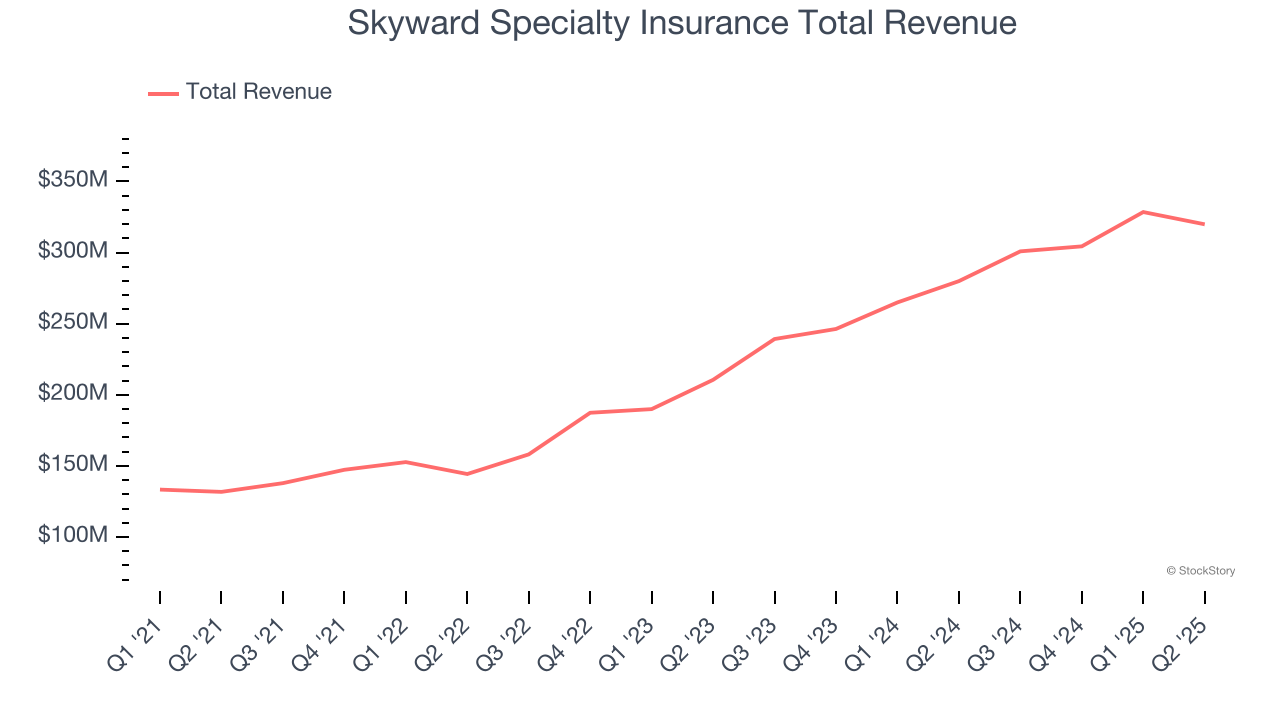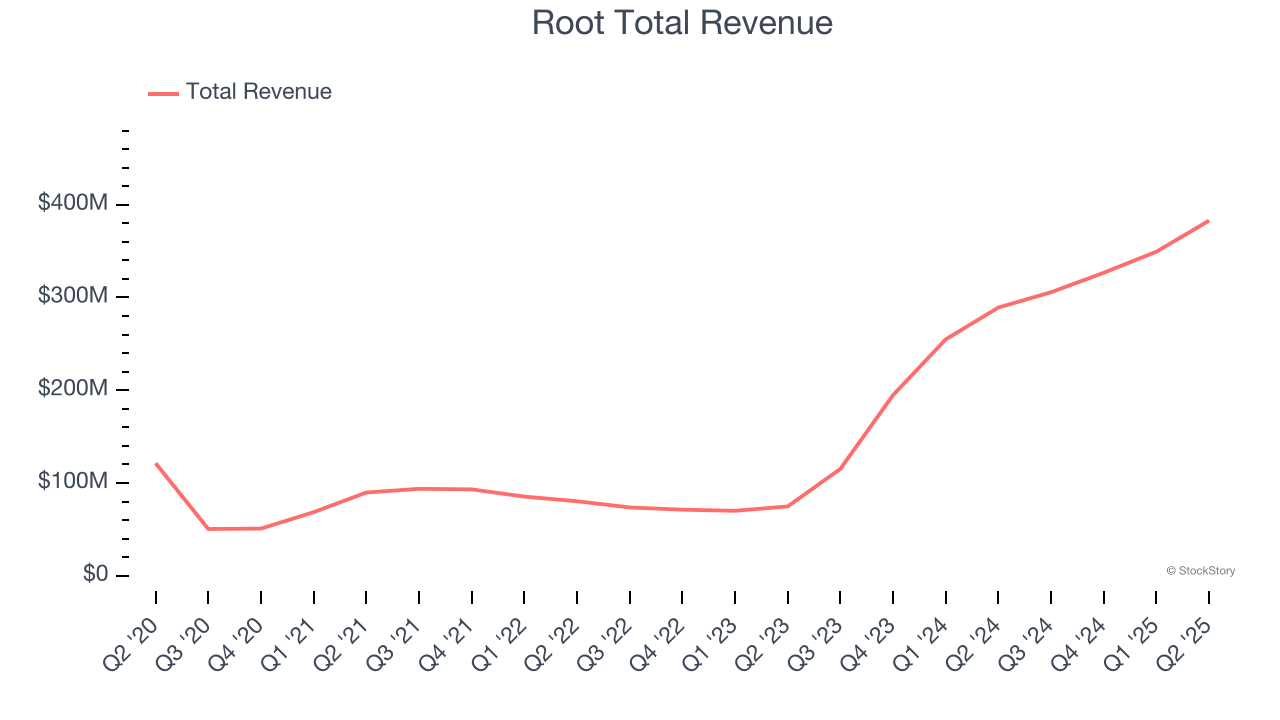
As the craze of earnings season draws to a close, here’s a look back at some of the most exciting (and some less so) results from Q2. Today, we are looking at property & casualty insurance stocks, starting with Skyward Specialty Insurance (NASDAQ: SKWD).
Property & Casualty (P&C) insurers protect individuals and businesses against financial loss from damage to property or from legal liability. This is a cyclical industry, and the sector benefits when there is 'hard market', characterized by strong premium rate increases that outpace loss and cost inflation, resulting in robust underwriting margins. The opposite is true in a 'soft market'. Interest rates also matter, as they determine the yields earned on fixed-income portfolios. On the other hand, P&C insurers face a major secular headwind from the increasing frequency and severity of catastrophe losses due to climate change. Furthermore, the liability side of the business is pressured by 'social inflation'—the trend of rising litigation costs and larger jury awards.
The 33 property & casualty insurance stocks we track reported a satisfactory Q2. As a group, revenues beat analysts’ consensus estimates by 1.5%.
In light of this news, share prices of the companies have held steady as they are up 4.6% on average since the latest earnings results.
Skyward Specialty Insurance (NASDAQ: SKWD)
Founded in 2006 to serve markets where standard insurance coverage falls short, Skyward Specialty Insurance (NASDAQ: SKWD) provides customized commercial property, casualty, and health insurance solutions for underserved or specialized market niches.
Skyward Specialty Insurance reported revenues of $319.9 million, up 14.3% year on year. This print fell short of analysts’ expectations by 1.4%. Overall, it was a mixed quarter for the company with an impressive beat of analysts’ book value per share estimates but a slight miss of analysts’ net premiums earned estimates.
Skyward Specialty Chairman and CEO Andrew Robinson commented, "Our results for the second quarter and for the first half of the year have been outstanding and reflect the strength of our specialized underwriting and claims capabilities, and our execution excellence. In an increasingly challenging market environment, our 18% growth for the second quarter and best ever 89.4% combined ratio are again a demonstration of the power of our portfolio diversity and our ability to deploy capital to attractive markets that enable us to grow underwriting profitability while managing our volatility. As market conditions continue to evolve, we are confident that the disciplined execution of our "Rule Our Niche" strategy will enable us to continue to deliver top quartile returns to our shareholders."

Unsurprisingly, the stock is down 1.9% since reporting and currently trades at $48.41.
Is now the time to buy Skyward Specialty Insurance? Access our full analysis of the earnings results here, it’s free for active Edge members.
Best Q2: Root (NASDAQ: ROOT)
Pioneering a data-driven approach that rewards good driving habits, Root (NASDAQ: ROOT) is a technology-driven auto insurance company that uses mobile apps to acquire customers and data science to price policies based on individual driving behavior.
Root reported revenues of $382.9 million, up 32.4% year on year, outperforming analysts’ expectations by 7.5%. The business had an incredible quarter with a beat of analysts’ EPS and net premiums earned estimates.

Although it had a fine quarter compared its peers, the market seems unhappy with the results as the stock is down 33.6% since reporting. It currently trades at $81.77.
Is now the time to buy Root? Access our full analysis of the earnings results here, it’s free for active Edge members.
Weakest Q2: Selective Insurance Group (NASDAQ: SIGI)
Founded in 1926 during the early days of automobile insurance, Selective Insurance Group (NASDAQ: SIGI) is a property and casualty insurance company that sells commercial, personal, and excess and surplus lines insurance products through independent agents.
Selective Insurance Group reported revenues of $127.9 million, down 89.3% year on year, falling short of analysts’ expectations by 90.3%. It was a disappointing quarter as it posted a significant miss of analysts’ revenue and EPS estimates.
Selective Insurance Group delivered the weakest performance against analyst estimates and slowest revenue growth in the group. As expected, the stock is down 6.9% since the results and currently trades at $84.24.
Read our full analysis of Selective Insurance Group’s results here.
Old Republic International (NYSE: ORI)
Founded during the Roaring Twenties in 1923 and weathering nearly a century of economic cycles, Old Republic International (NYSE: ORI) is a diversified insurance holding company that provides property, liability, title, and mortgage guaranty insurance through its various subsidiaries.
Old Republic International reported revenues of $2.21 billion, up 18% year on year. This number was in line with analysts’ expectations. Overall, it was a strong quarter as it also recorded an impressive beat of analysts’ book value per share estimates and a solid beat of analysts’ net premiums earned estimates.
The stock is up 18.1% since reporting and currently trades at $43.23.
Employers Holdings (NYSE: EIG)
With roots in Nevada and a strong concentration in California where 45% of its premiums are generated, Employers Holdings (NYSE: EIG) is a specialty provider of workers' compensation insurance focused on small and select businesses engaged in low-to-medium hazard industries across the United States.
Employers Holdings reported revenues of $246.3 million, up 13.5% year on year. This print surpassed analysts’ expectations by 9.1%. Zooming out, it was a slower quarter as it produced a significant miss of analysts’ EPS and book value per share estimates.
The stock is down 7.3% since reporting and currently trades at $42.26.
Read our full, actionable report on Employers Holdings here, it’s free for active Edge members.
Market Update
Thanks to the Fed’s series of rate hikes in 2022 and 2023, inflation has cooled significantly from its post-pandemic highs, drawing closer to the 2% goal. This disinflation has occurred without severely impacting economic growth, suggesting the success of a soft landing. The stock market thrived in 2024, spurred by recent rate cuts (0.5% in September and 0.25% in November), and a notable surge followed Donald Trump’s presidential election win in November, propelling indices to historic highs. Nonetheless, the outlook for 2025 remains clouded by potential trade policy changes and corporate tax discussions, which could impact business confidence and growth. The path forward holds both optimism and caution as new policies take shape.
Want to invest in winners with rock-solid fundamentals? Check out our Top 5 Quality Compounder Stocks and add them to your watchlist. These companies are poised for growth regardless of the political or macroeconomic climate.
StockStory is growing and hiring equity analyst and marketing roles. Are you a 0 to 1 builder passionate about the markets and AI? See the open roles here.


















